Product Hub July 03, 2015
The Digital Decision
Direct-to-garment and dye-sublimation printing have grown by leaps and bounds, and decorators should be investing in these technologies.
A decade ago, Brian Conway noticed a trend. The owner of contract decorating shop A.I.R. Conway (asi/700040) in Collingdale, PA, found that more and more of his clients were clamoring for high-quality full-color artwork, but they wanted it in smaller and smaller quantities. At the time, A.I.R. Conway offered 500-piece minimums, plus expensive screen and film charges, for process screen-printing jobs.
To fill that growing gap in service, Conway invested in a direct-to-garment printer from Kornit (asi/14972). The investment has paid off. “It’s opened up the door to a lot of new customers,” Conway says. “Our customers can sell better to their customers. They don’t have to turn anyone away anymore.” The digital side of A.I.R. Conway’s business has been steadily rising, with an average annual growth rate of 30%. “We’re very busy with digital. We run hard, eight hours a day,” Conway says, adding that his company is considering purchasing another direct-to-garment printer in the near future.
Screen printing and embroidery are still the company’s bread and butter, but direct-to-garment printing is the jam on the toast – making up about one-fifth of A.I.R. Conway’s overall revenue. Conway says he doesn’t expect “quality-driven digital” to overtake “quantity-driven” methods anytime soon. “It can’t hold the throughput that screen-printing presses can hold,” he says. “It’s a nice niche where people can get the 12 pieces they want and not be rocked with expensive fees.”
For embroidery shops looking to diversify or break into trendy multimedia designs, digital printing is often an ideal addition: It takes up less space and is a cleaner process than traditional screen printing. Still, many decorators are still hesitant to dive into digital, discouraged by early kinks in the technology. But digital processes like direct-to-garment and dye-sublimation printing continue to improve, and it may be time for decorators who initially dismissed the technology to take another look. We outline the strengths and weaknesses of direct-to-garment printing and sublimation, to help you decide which might be right for your shop.
Direct-to-Garment Printing
The Dream Junction in Santa Ana, CA, started out as your average screen-printing shop that happened to do a bit of direct-to-garment printing on the side. The owners of the family company quickly realized their business model was flawed, with Dream Junction barely distinguishable from the already flooded local screen-printing market. “Being in the heart of Orange County, there was kind of one on every corner,” explains Blair Dorsey, CEO and one of six co-owners. “Anybody can set up a screen-printing press in their garage.”
Rather than give up, Dorsey and her family just switched gears, latching onto Dream Junction’s robust digital printing sales and focusing on back-end e-commerce fulfillment. The company jettisoned its screen-printing equipment in favor of a multimillion-dollar investment into direct-to-garment technology, buying six Kornit printers over the last year, with plans to add four more. “It’s incredible,” Dorsey says of her company’s dizzying success with digital. “We’ve actually never done any form of advertising. It’s all been word of mouth.”
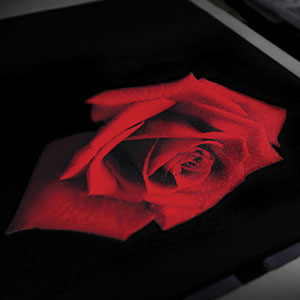
Decorator Dream Junction has built its business through direct-to-garment printing.
The Dream Junction prints 1,000 shirts per machine per day, sometimes for clients with millions of images stored in the system. “For some of our printing partners, we never print the same image twice,” Dorsey says. She adds that clients love the unlimited colors and rich, photographic quality of the printed garments. “We’re able to print 100% to the file,” she says. Plus, the garments have a softer hand than traditional screen prints: “You don’t have the thick piles of ink going on top of each other.”
For Dream Junction and other large-scale direct-to-garment printers, much of the appeal, besides the vibrancy of the prints, is the high barrier of entry, costing at least half a million dollars to set up a production-friendly digital printer and dryer. “That really culls the herd out a little bit,” says Marshall Atkinson, chief operating officer of Visual Impressions in Milwaukee.
Of course, there are opportunities in direct-to-garment printing for decorators not willing or able to make as large of an investment into digital. It’s all about targeting markets that reward direct-to-garment printing’s strengths, rather than trying to work around its limitations.
Strengths
Image Quality: The ability to print vibrant, photographic-quality artwork without spending a lot of time and money on setup is one of the big benefits of direct-to-garment printing. “You pretty much just get an image, put it in the software, line it up and hit the green button. It’s pretty simple,” says Mike Polizzi, who decorates shirts with an AnaJet (asi/16000) printer through his home-based shop Embroider It in Bloomsburg, PA. “I feel like the quality is better than when I used a silk-screener, when the logos would start getting wrinkly after so many washes.”
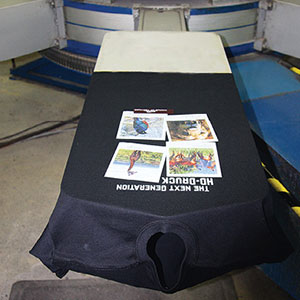
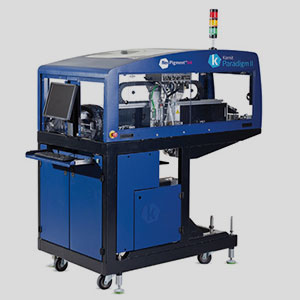
The new Paradigm II from Kornit (asi/14972; circle 103 on Free Info Card) transforms a press into a direct-to-garment/screen hybrid and allows for photorealistic direct-to-garment prints on screen-printed tees.
Unlimited Colors: Direct-to-garment allows decorators to print artwork with lots of colors without having to tack on extra charges. “If you have an order of 30 shirts with 12 colors, that’s going to be a really expensive T-shirt to screen print,” Atkinson says. “To print direct-to-garment, it’s not too bad.”
On-Site Capabilities: Direct-to-garment printing is an ideal back-end solution to support design-it-yourself T-shirt and other e-commerce sites, or to handle mobile on-demand printing at festivals. AnaJet has demonstrated this capability at a number of events. On the extreme end, says AnaJet Marketing Director Paul Crocker, was Google’s Androidify event in Times Square last year. The tech company’s event marketing agency, The Magnetic Collaborative, cranked out more than 1,700 personalized T-shirts on AnaJet printers during the two-day event.
Low Minimums: Direct-to-garment printers also allow decorators to take on short-run jobs – the kind traditional screen printers have turned away because it costs too much to burn multiple screens for half a dozen shirts. “If they’re turning those orders away to a local provider of direct-to-garment printing, not only do they lose the short run, they may end up losing the slightly longer run from that customer too,” says Larry Kaufman, product manager at Epson. “You never want to turn your customer over to a competitive business.”
Samples: Printing a sample garment with direct-to-garment printing can be an inexpensive way to placate customers, allowing them to see the placement, approximate color, design size and quality of the shirt itself. That’s how FPS Apparel (asi/53475) uses its direct-to-garment printers, reserving them for one-off designs and customer samples, says Kevin Johnstone, sales and marketing manager.
Limitations
Dark Garments:Direct-to-garment printing technology is at its best on white 100% cotton shirts. Black, navy and other dark fabrics need to be pretreated and dried to prepare them for white ink, without which the other colors would fade into the dark fabric. Not only does this add significantly to the time required for each shirt, but white inks, formulated with titanium dioxide, are “more expensive per square foot and less production-friendly” than other colors, says Christopher Bernat, co-owner of Vapor Apparel (asi/93396), which manufactures sublimation-ready garments, in addition to offering digital decorating services. “Titanium dioxide just isn’t an easy chemical to work with. It’s not fun yet,” he adds. “Everybody’s chasing a production-friendly version of [white ink]. I have no doubt it’ll show up.”
Pretreatment: A common cause of poor printing results is the inconsistent application of pretreatment by decorators – a problem being tackled by several companies. Some vendors sell black T-shirts already pretreated and ready for digital printing. Kornit printers have the ability to pretreat while they print, saving decorators a lot of time and effort, says Yuval Neria, director of product marketing for Kornit. “This is a one-pass process,” he adds.
Pantone Colors: If a client has a specific corporate color, the direct-to-garment printed garment will match it very closely, but it likely won’t be exact, says Atkinson. For some brands, though, close isn’t good enough. Manufacturers are also working on improving in this area. Kornit, for example, offers a six-color printer, adding red and green inks to the traditional CMYK mix for a richer, more extensive color palette.
Regular Use: Direct-to-garment printers must be constantly running to be the most effective. Infrequent use can lead to clogged printhead nozzles and hair-pulling frustration, not to mention wasted time and money, Aktinson says. “A lot of people buy a direct-to-garment printer and never use it,” he adds. “It becomes a big boat anchor, and they hate it.” Run the numbers on how much potential direct-to-garment work you’re losing before taking the plunge.
Polyester: It’s best to use natural fibers, particularly cotton, when working with this technology. In most cases, polyester is a no-no. “The ink just physically won’t adhere to polyester,” Kaufman explains. Even using a cotton-polyester blend will diminish the print quality. This is another area manufacturers are working on, however. Kornit’s water-based pigment ink allows for printing on polyester and other synthetic fabrics, though it’s a more complicated process than working with cotton, Neria says. “You need to use the printer in a slightly different way,” he adds.
When to Add
Direct-to-garment printing is probably not the best choice for decorators who deal mostly in black T-shirts or performance fabrics. However, certain markets – like the outdoor retail and tourism industries – reward decorators for natural-colored tees with photographic and vector art, in which case direct-to-garment printing may be the most cost-effective way of catering to those buyers, he adds. It’s also the way to go if you’re trying to capitalize on short-run work or catch online dollars, perhaps from a design-it-yourself T-shirt site.
In direct-to-garment printing’s early days, many decorators shied away, for example, turned off by unreliable, cobbled-together machines – often hacked Epson printers and inks. The market has since matured, with manufacturers – including Epson itself – introducing dedicated direct-to-garment solutions, with increased print speed and reliability. Expect the future to bring a marriage of traditional screen printing and digital technologies. Consider, for example, Kornit’s recently introduced Paradigm II, which transforms a press into a direct to garment-screen hybrid. “This may become the solution of choice for many [decorators] who have yet to migrate to digital,” Neria says.
Sublimation
Two years ago, the designers at FPS Apparel (asi/53475) had a winning idea: Take an existing hoodie and a swatch of fabric sublimated with a bold design and marry the two together, sewing the so-called “sublimated accent” inside the hood to create a custom lining. “We’ve gotten an incredible response,” says Kevin Johnstone, sales and marketing manager at FPS.
One of the most positive examples was the sublimated hoodie FPS created for UPS employees. The decorator added a bright yellow plaid hood lining to a dark brown full-zip hoodie with an embroidered logo on the side and convinced its client to add the item to the UPS company store. Since then, the hoodie has become the number-one selling item in the employee catalog, Johnstone says.
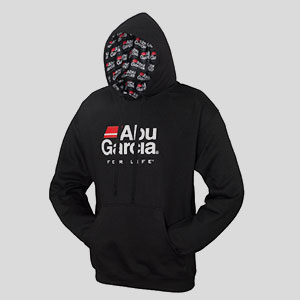
FPS Apparel (asi/53475; circle 105 on Free Info Card) has used sublimation as a bold branding accent in unexpected places, like sublimated hoodie liners on sweatshirts (FL185).
Since the initial positive feedback, FPS has started experimenting with sublimated accents on other garments: sublimating the sleeves of baseball shirts and side inserts of tank tops, for example. “It takes a garment to another level. It’s kind of the main thing we’re focusing on now,” Johnstone says.
FPS is making waves in what is considered the highest end of the market: sublimating the fabric itself before turning it into apparel rather than decorating a premade garment. But there are many other ways for screen printers to add sublimation to their lineup of services. And with the performance apparel market growing increasingly dominant, there are plenty of good reasons to take another look at this polyester-friendly technology.
Sublimation inkjet printers use special dyes and transfer papers, which are then heat-pressed onto polyester garments. The heat and pressure cause the ink to convert into a gas and bond with the manmade shirt fibers on a molecular level – leaving a colorful design that doesn’t flake or fade. It’s an attractive solution from a branding perspective because of the artwork’s relative permanence. “Unless you stick it out in the Gobi Desert for five years in a row, nothing is going to happen to it,” Bernat says. “Your shirt will probably fall apart long before the design fades.”
Strengths
Performance Apparel: Performance apparel, particularly for sports and activewear, has been exploding in recent years. Dye sublimation is often the perfect decoration choice, since it’s designed to bond to synthetics. The vibrant designs, paired with practical features like moisture wicking and UV protection, help decorators up the perceived value of a garment and increase profit margins.
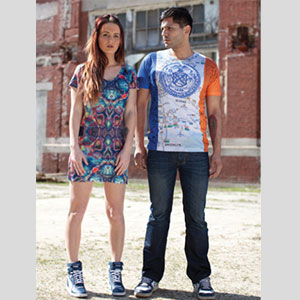
Stunning allover prints are possible through sublimation, as demonstrated by Vapor Apparel (asi/93396; circle 104 on Free Info Card).
Diversification: Sublimation can also be used to decorate hard goods, giving a decorator more markets to target. Done right, a decorator can see a return on investment in as little as three months by focusing on high-markup items like phone cases, says Catalina Frank, a product manager for Epson’s sublimation printers. Depending on the level of customization, a printer could charge a markup as high as 200% on a sublimated case, she says. For decorators targeting sports markets, consider other ways to add value. Instead of just decorating jerseys, try offering custom sublimating services for skis, snowboards and other equipment.
Unlimited Colors: Sublimation offers the opportunity to use as many colors as the client or decorator wants. Even at the entry-level use of “spot-hit sublimation,” decorators can add a small full-color design to a garment. It requires the smallest investment, but done well, can also reap significant rewards, Bernat says.
Allover Printing: Allover looks are very popular these days, and with sublimation, it’s fairly easy to “take an existing garment and hit the entire thing with ink,” Bernat says. The allover look is particularly popular in the athletic world, for items such as wrestling singlets and paintball jerseys.
Cut and Sew: The premium level of sublimation is cut-and-sew, where the fabric is sublimated using a roll-to-roll press before being constructed into a finished garment. It has the highest investment cost, but many customers love the results. Vapor Apparel has seen its demand for cut-and-sew sublimation services grow dramatically year over year, so much so that the company is investing $1.3 million to expand that side of the business into a new 30,000-square-foot manufacturing facility in South Carolina.
Limitations Creases: Allover printing is an “imperfect solution,” according to Bernat, since areas of the garment that don’t lie absolutely flat won’t receive color. Typically, in a sublimated T-shirt, you see this with white crease marks under the arms. Many decorators get creative to minimize the issue, working the undyed areas into the design, Frank says. “They go to extremes just to hide those possible defects,” she says. Other potential solutions include marbleizing the artwork around the armpits, or starting out with an off-white or gray blank so the undecorated portions are less of a stark contrast.
White Garments: For the most part, sublimation is limited to white fabrics. For decorators focusing on spot-hit designs, this can be a detractor, since end-buyers like more options than basic white tees. However, there are several sublimation-friendly shades – light earth tones and sea foams – that perform well. “People have these brain locks from the original manufacturer that you can only sublimate on white,” Bernat says. “It’s just not true. You can’t add white, and you can’t take color away, but if your art and shirt color work together, you can get a lot more than a $10 credit in your market.”
Cotton: Because of the chemical process involved, sublimation doesn’t work with natural fibers like cotton. Using fabric blends can be tricky, especially if your customer is looking for Pantone color-matching. “1% of cotton equals a 1% loss of color control,” Bernat says. “It’s going to be muted. The fact that you can’t make Coca-Cola red pop is a loss of control.”
When to Add
Many decorators are already servicing clients in the lucrative sports and fitness markets, clients who are easily sold on the benefits of performance fabrics. Sublimation is often the best decoration technique for such apparel. The ability to offer allover prints or custom cut-and-sew sublimation is a great differentiator, but even starting out on the lower end, adding a full-color spot-hit sublimation to a performance tee can be an easy way to increase profit margins. Decorators must determine what level of investment they can handle. If they expect to do smaller runs with the technology, a digital sublimation printer is likely the right solution. For high-volume work, an offset sublimation printer may be necessary. FPS Apparel provides both options to clients, but orders with fewer than 500 pieces cost significantly more, since the decorator can’t take advantage of the speed of the offset process, Johnstone explains.
The popularity of performance fabrics will continue to grow, especially as the price of cotton increases and interest in recycled polyester fiber rises. In the corporate world especially, expect sublimation to follow the same growth trend. “Brands like the fact that sublimation doesn’t fade over time because that’s their logo fading,” Bernat says. It’s a more expensive technology than screen-printed cotton, he adds, but for decorators who specialize in building apparel solutions for clients, rather than selling on low price alone, sublimation can be a winning addition to their existing suite of services.
Equip Yourself
Adding digital printing services to your shop can be a significant investment. Direct-to-garment printers range in cost: Epson’s new SureColor F2000 lists at just under $20,000, whereas Kornit’s top-of-the-line models can run as high as $400,000 each. Sublimation printers also vary, depending on model size. Epson sells a 44” sublimation printer for $8,500, and a 64” printer for just under $20,000. On the other hand, an offset sublimation printer, for high-volume decoration, might come with a million-dollar price tag.
Of course, a decorator needs a lot more than just the printer itself to break into digital printing. Here are some other elements you may need.
Raster Image Processor (RIP) Software: To keep your images from pixelating, you need a program that will rasterize them. Some manufacturers include RIP software in their product bundle, but there are third-party solutions available if that’s not the case. “A lot of clients are used to screen-printed art where you can get away with murder,” says Christopher Bernat, chief revenue officer for Vapor Apparel (asi/93396). That doesn’t hold true when it comes to sublimation and direct-to-garment printing, he adds.
Heat Press or Heat Tunnel: Both sublimation and direct-to-garment printing require heat, either to complete the sublimation process or cure the digital inks. Sublimators can use either a clamshell press or a roll-to-roll press depending on the size and volume of their work. For direct to garment, a heat tunnel is the secret to improved efficiency, says Marshall Atkinson, COO of Visual Impressions. Depending on the size and sophistication, a heat press could cost anywhere from several hundred to several thousand dollars. Catalina Frank, product manager for Epson, recommends that sublimation printers consider outsourcing at first if they can’t afford a press. “There are companies dedicated to just heat-pressing,” she adds.
Ink: The quality of the garments you decorate directly relates to the quality of printer inks used, experts say. “I don’t know why people chase $30 ink,” Bernat says. “The ink can really kill these printers if it’s not made right.”
Transfer Paper: A roll of transfer paper for sublimation printers could cost several hundred dollars, depending on the size.
Pretreatment Machine: Low-volume direct-to-garment printers may be able to get away with a paint roller or spray gun for pretreatment at first. A dedicated pretreatment machine costs several thousand dollars.
Theresa Hegel is a senior staff writer for Stitches. Contact her at thegel@asicentral.com and follow her on Twitter at @TheresaHegel.

Product Hub
Find the latest in quality products, must-know trends and fresh ideas for upcoming end-buyer campaigns.
